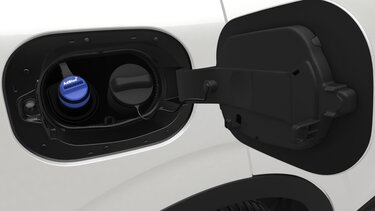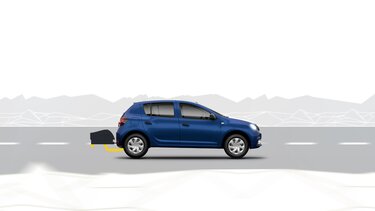New regulations for diesel and petrol engines
It is in keeping with the Dacia brand promise that we continue to offer you affordable solutions while being transparent about new regulations governing fuel consumption and emissions.
- Blue dCi diesel engines
- Petrol engines with a particulate filter (FAP)
Blue dCi diesel engines
To reduce pollutant emissions, the new Blue dCi diesel engines are equipped with a Selective Catalytic Reduction (SCR*) system functioning with AdBlue®. This technology continuously converts the nitrogen oxide (NOx) emitted by diesel engines into non-hazardous gases (steam and nitrogen).
Effective in all situations, this technology has no impact on Blue dCi engine performance. Its use allows compliance with new standards that are more stringent and demanding.
Advantages
- Comprising 32.5% pure urea and 67.5% demineralised water, AdBlue® is a colourless and non-hazardous aqueous solution.
- AdBlue® is available in most petrol stations.
- Your car reminds you gradually when it's time to refill the AdBlue® tank.
- One full AdBlue® tank covers about 6 to 8 full** fuel tanks.
Worth noting
- AdBlue® must be used in its pure form.
- It has its own tank which can be accessed easily by an outer door shared with the diesel tank, or a separate door.
- The diesel tank must not be filled with AdBlue®, and vice versa.
- In the event of an error, do not start the engine, as you could damage the SCR system.
Petrol engines with a particulate filter
To reduce particulate emissions, the new direct injection petrol engines now include a particulate filter (FAP) in the exhaust pipe.
This technology removes particles from exhaust gases by trapping them in a microporous honeycomb structure and then burning them through an automatic and very regular regeneration process.
The range of petrol engines equipped with this technology has been renamed TCe FAP.
Advantages
The particulate filter does not require any maintenance.
It has no impact on your car's driving.
And lastly, it doesn't affect fuel consumption and CO2 emissions.
Also read
WLTP emission standard
A regulation more relevant to actual driving behaviour and daily consumption values.
(*) Selective Catalytic Reduction involves injecting ammoniac (called NH3) from AdBlue into the exhaust catalyst. The chemical reaction caused converts nitrous oxides (NOx) into non-polluting gases (steam and harmless nitrogen).
(**) AdBlue consumption depends on the car's conditions of use, equipment and driving style. The capacity of the AdBlue tank depends on the model; it is generally between 15 and 20 litres. The price of AdBlue varies according to its packaging, but is still attractive for consumers.






